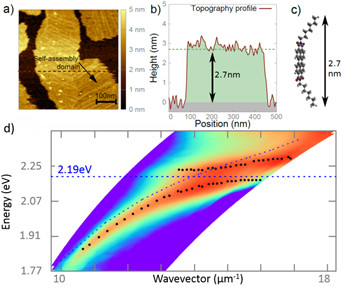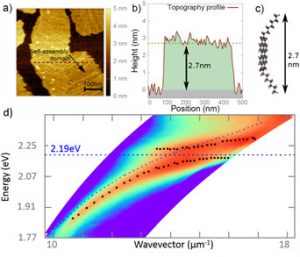The control of the molecular arrangement of optically-active organic fluorophores on a metal surface opens new opportunities for combining plasmon waves confined at the nanometer scale with organic light sources or light-amplifying media. In collaboration with the team of Sylvain Barbay (C2N / Marcoussis), we took advantage of the self-organization properties of specific organic molecules to maximize the electromagnetic interaction between organic dyes and plasmon waveguides. The organic medium embeds a high density of fluorophores, oriented along the plasmon field and exhibiting a strong collective excitation mode (exciton). We demonstrated experimentally that this unique combination of assets permits to attain the strong-coupling regime between exciton and plasmon. In this regime energy exchanges between molecules and metal is faster than with the environment, thus giving rise to hybrid excitated states of both fundamental and practical interest in photonics. The analysis of spontaneous emission by these hybrid excitations permitted us to clarify the physics of light-emission in the context of a strong coupling between exciton and plasmon.
Plasmonics is an emerging branch of photonics that uses metal nanostructures to control lightwaves on the nanometer scale. There is an increasing interest for its synergistic combination with the photonic functionalities offered by organic dyes in view of turning plasmonics from a passive optical technology to an active one.
In this context we have developed an organic dye-doped material grown on gold surfaces which presents a unique association of assets that maximizes the interactions between dyes and surface plasmons. First, the density of fluorophore is much higher than that usually achieved in polymer matrices. Second, all the fluorophores are oriented vertically with respect to the gold surface, along the optical electric field of the surface plasmon. Third, the overlap between conjugated π-electron orbitals of neighboring fluorophores gives rise to a collective excitation mode (charge-transfer Frenkel exciton) exhibiting a large oscillator strength. This spectrally narrow resonance is shifted towards lower frequencies, in a range which is compatible with low-loss propagation of plasmon waves. This well-ordered material grows by an easily implemented self-assembly process under specific conditions of vacuum deposition, taking advantage of the liquid-crystal behavior of the molecules.
By measuring the angle-resolved spectral reflectivity, we have established the dispersion relationship of our system (Figure 1), where a low reflectivity (in red in Figure 1.d) corresponds to the excitation of the different modes. The surface plasmon dispersion and the excitonic band at fixed frequency form an anticrossing pattern, a signature of the so-called strong coupling regime. In this regime, energy exchanges between molecules and metal is faster than towards the environment, thus giving rise to hybrid plasmon-exciton states of both fundamental and practical interest in photonics.
Finally, the angle-resolved detection of the luminescence shows that the molecules relax by spontaneous emission in this hybridized electromagnetic environment. This understanding of light-emission under strong exciton-plasmon coupling opens the route to plasmon amplification processes and the design of nanoscale plasmonic lasers.

Reference
“Strong Coupling between Self-Assembled Molecules and Surface Plasmon Polaritons”, J. Bigeon, S. Le Liepvre, S. Vassant, N. Belabas, N. Bardou, C. Minot, A. Yacomotti, A. Levenson, F. Charra, and S. Barbay, Journal of Physical Chemistry Letters 8, 5626 (2017)
Collaboration
- S. Le Liepvre, S. Vassant, F. Charra – SPEC, CEA, CNRS, Université Paris-Saclay
- J. Bigeon, N. Belabas, N. Bardou, C. Minot, A. Yacomotti, A. Levenson, S. Barbay – Centre de Nanosciences et de Nanotechnologies, CNRS, Université Paris-Sud, Université Paris-Saclay, C2N Marcoussis
Contact CEA: Fabrice Charra and Simon Vassant , IRAMIS/SPEC, Laboratoire d'Electronique et Photonique Organique (LEPO)




